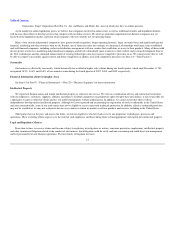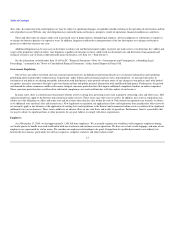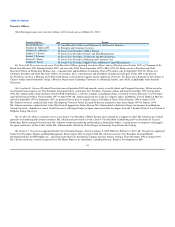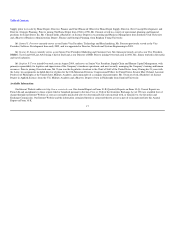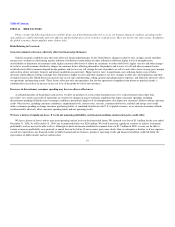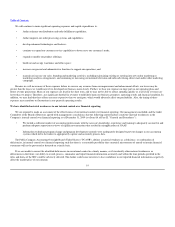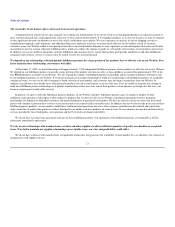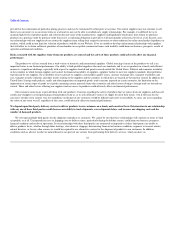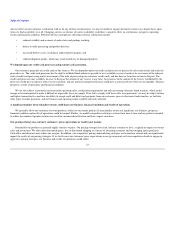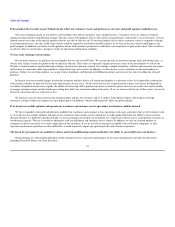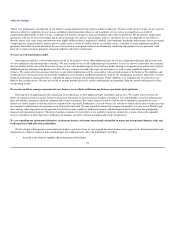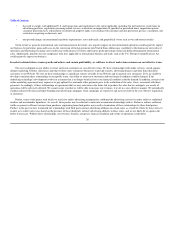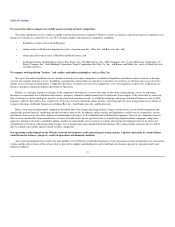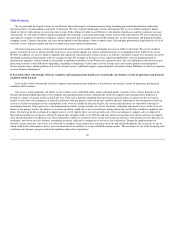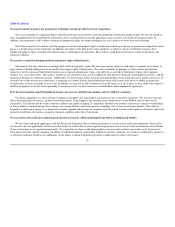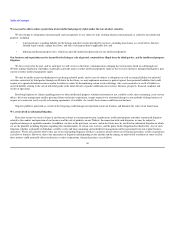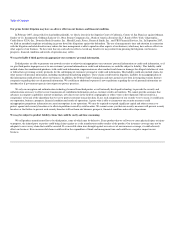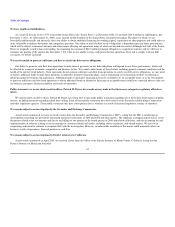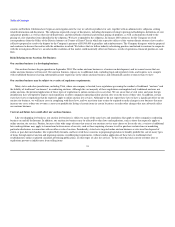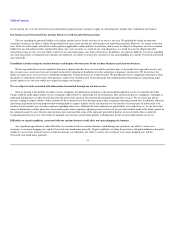Overstock.com 2009 Annual Report Download - page 27
Download and view the complete annual report
Please find page 27 of the 2009 Overstock.com annual report below. You can navigate through the pages in the report by either clicking on the pages listed below, or by using the keyword search tool below to find specific information within the annual report.
Table of Contents
If the products that we offer on our Website do not reflect our customers' tastes and preferences, our sales and profit margins would decrease.
Our success depends in part on our ability to offer products that reflect consumers' tastes and preferences. Consumers' tastes are subject to frequent,
significant and sometimes unpredictable changes. Because some of the products that we sell consist of manufacturers' and retailers' excess inventory, we have
limited control over some of the specific products that we are able to offer for sale. If our merchandise fails to satisfy customers' tastes or respond to changes
in customer preferences, our sales could suffer and we could be required to mark down unsold inventory, as we have in the past, which would depress our
profit margins. In addition, any failure to offer products in line with customers' preferences could allow our competitors to gain market share. This could have
an adverse effect on our business, prospects, results of operations and financial condition.
We face risks relating to our inventory.
For our direct business, we purchase the merchandise that we sell on our Website. We assume the risks of inventory damage, theft and obsolescence, as
well as risks of price erosion for products that we purchase directly. These risks are especially significant because some of the merchandise we sell on our
Website is characterized by rapid technological change, obsolescence and price erosion (for example, computer hardware, software and consumer electronics)
and because we sometimes make large purchases of particular types of inventory. In addition, we often do not receive warranties on the merchandise we
purchase. Subject to our returns policies, we accept returns of products sold through our fulfillment partners and we have the risk of reselling the returned
products.
In the past we have recorded charges for obsolete inventory and have had to sell certain merchandise at a discount or loss. It is impossible to determine
with certainty whether an item will sell for more than the price we pay for it. To the extent that we rely on purchased inventory, our success will depend on
our ability to liquidate our inventory rapidly, the ability of our buying staff to purchase inventory at attractive prices relative to its resale value and our ability
to manage customer returns and the shrinkage resulting from theft, loss and misrecording of inventory. If we are unsuccessful in any of these areas, we may be
forced to sell our inventory at a discount or loss.
We purchase some of our inventory from foreign markets and pay for inventory with U.S. dollars. If the dollar weakens with respect to foreign
currencies, foreign vendors may require us to pay higher prices for products, which could negatively affect our profit margins.
If we do not successfully optimize and operate our warehouse and customer service operations, our business could be harmed.
We have expanded, contracted and otherwise modified our warehouse and customer service operations in the past, and expect that we will continue to do
so. If we do not successfully optimize and operate our warehouse and customer service operations, it could significantly limit our ability to meet customer
demand. Because it is difficult to predict demand, we may not manage our facilities in an optimal way, which may result in excess or insufficient inventory or
warehousing capacity. We may be unable to adequately staff our fulfillment and customer service centers. In addition, we rely on a limited number of
companies to deliver inventory to us and to ship orders to our customers. If we are not able to negotiate acceptable terms with these companies, or they
experience performance problems or other difficulties, it could negatively impact our operating results and customer experience.
The loss of key personnel or any inability to attract and retain additional personnel could affect our ability to successfully grow our business.
Our performance is substantially dependent on the continued services and on the performance of our senior management and other key personnel,
including Patrick M. Byrne, our Chief Executive
24


